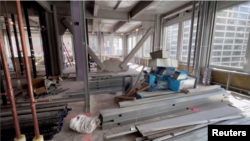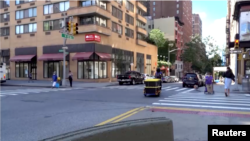Hybrid work is here to stay, and if cities are to thrive, they must adapt to the new reality that workers will be downtown less often. That’s according to a new report that analyzes the COVID-19 pandemic’s lasting impact on office and retail space.
“What has fundamentally changed is just the broad uptake and the persistence of hybridity,” says Ryan Luby, an associate partner at McKinsey & Company, a management consulting firm that released the report. “And that has knock-on implications for demand for office, for residential, for retail, what kind of space is demanded, where it is demanded, and that has real implications for urban vitality, vibrancy and the kinds of buildings that we demand.”
Now that they aren’t making their daily commutes to downtown offices, people are doing their eating out and shopping elsewhere. The report finds that foot traffic near stores in urban areas is still 10% to 20% lower than pre-pandemic levels, and office attendance is still down by about 30% on average in major cities across the world.
The New York City metropolitan area lost 5% of its population from mid-2020 to mid-2022, while the San Francisco area lost 6%. The numbers suggest that many of the people who left big cities during the pandemic are not moving back, the report said, which presents another challenge for cities trying to bounce back from pandemic-driven losses.
In Washington, the daytime population plunged 82% from February 2020 to February 2021. And a 2023 poll finds that two-thirds of Washington-area workers whose jobs can be done remotely prefer to work from home a majority of the time. Thirty-eight percent of people surveyed said they’d like to work from home all of the time.
City leaders and planners are preparing for a future that adjusts to this new reality.
“About 50 percent of our population can still remote work,” says Salah Czapary, director of the D.C. Mayor's Office of Nightlife and Culture. “Some neighborhoods have not returned to pre-COVID levels of economic activity. … Our short-term strategy is activating the space, attracting festivals and making it easier for people to close streets — whether it's for a farmers market or a music festival downtown — doing that to support what has traditionally been our economic engine of the city, which has been downtown.”
Luby, one of the report’s authors, says the most resilient cities have a mixture of office, residential and retail real estate.
“People are coming into those areas for reasons other than work,” he says. “I think the imperative, as we think about it from the public policy perspective, is really to encourage or incentivize what we think about as mixed-use development, in which folks will be present in these areas for reasons other than just work.”
Washington’s city leaders, for example, are looking for ways to meet the moment.
“Our long-term strategy is really attracting new residents to downtown by changing the buildings from commercial to residential,” Czapary says. “That will eventually attract grocery stores and other types of nightlife and restaurants and things that make neighborhoods attractive to live in.”
By 2030, demand for office space will be an average of 13% lower in major cities around the world than it was in 2019, according to the report. San Francisco is the most affected city in the United States in terms of demand for office space, with sale prices per square foot down 24% compared with 2019, while the asking price for rents is 28% lower than in 2019. The report also predicts that demand for retail space in San Francisco will be 17% lower in 2030 than in 2019.
Adjusting to this new reality could take time, Luby says, because people who own office space in major cities are still expecting prices to rebound as they did in pre-pandemic times.
“Because a commercial real estate office, in particular, tends to be on a five- to-10-year lease, you’ve got a slow-motion dynamic playing out,” Luby says. “And until you get buyers and sellers in the market to agree that we're in a new normal and adjusting prices downwards, it’s really going to be difficult to get at-scale adjustment."










